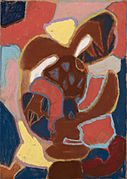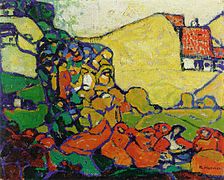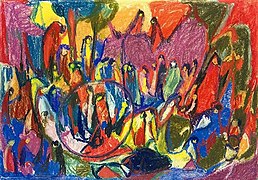Adolf Hölzel

Adolf Richard Hölzel (13 May 1853 – 17 October 1934) was a German painter. He began as a Realist, but later became an early promoter of various Modern styles, including Abstractionism.
Biography
Hölzel was born in

After completing his studies, Hölzel married and divided his time between Munich and
During his time in Dachau, Hölzel's work began moving toward abstraction, reflecting his interest in such principles as the
In 1905, Hölzel was appointed to replace
Tired of the continuous opposition from his colleagues, Hölzel retired in 1919, but continued to give private lessons and work as a freelance painter. He died in obscurity in 1934, in Stuttgart. His personal papers have been preserved at the Staatsgalerie Stuttgart. In 2005, the non-profit "Adolf Hölzel-Stiftung" was created to preserve and promote his works.
Selected paintings
-
Composition
-
Journey
-
Figures in a Landscape
-
Composition in Red
-
Adoration
Footnotes
References
- Wolfgang Venzmer (1972), "Hölzel, Adolf", Neue Deutsche Biographie (in German), vol. 9, Berlin: Duncker & Humblot, pp. 339–340; (full text online)
Further reading
- Marion Ackermann, Gerhard Leistner, Daniel Spanke (Eds.): Kaleidoskop. Hoelzel in der Avantgarde. Kehrer Verlag, Heidelberg 2009, ISBN 978-3-86828-089-0.
- Dörthe Jakobs, Viola Lang: "Das einzige Wandbild von Adolf Hölzel. Der Kruzifixus in der evangelischen Pauluskirche in Ulm." In: Denkmalpflege in Baden-Württemberg. #40, Vol.1 pgs. 45–50 (Online)
- Oliver Jehle: "Über künstlerische Religion. Adolf Hölzels Malerei als spekulative Theologie." In: Christoph Dohmen (Ed.): Religion als Bild – Bild als Religion. Schnell & Steiner, Regensburg 2011 ISBN 978-3-7954-2546-3
- ISBN 3-89322-421-1.
- Wolfgang Kermer (Ed.): Adolf Hölzel: Einiges über die Farbe in ihrer bildharmonischen Bedeutung und Ausnützung: zur Farbe. Mit einer Einführung von Wolfgang Kermer. Stuttgart: Staatliche Akademie der Bildenden Künste Stuttgart, 1997 (WerkstattReihe / [Staatliche Akademie der Bildenden Künste Stuttgart], ed. Wolfgang Kermer; 3)
- ISBN 3-931485-67-6.
- Alexander Klee: Adolf Hölzel und die Wiener Secession. Prestel Verlag, München 2006. ISBN 3-7913-3594-4.
- Karin von Maur: Der verkannte Revolutionär: Adolf Hölzel. Werk und Wirkung. Hohenheim Verlag, Stuttgart 2003 ISBN 3-89850-112-4.
- Christoph Wagner, Gerhard Leistner (Eds.): Vision Farbe. Adolf Hölzel und die Moderne. Wilhelm Fink, Paderborn 2015, ISBN 978-3-7705-5258-0.
External links
- Adolf-Hölzel-Stiftung, website home page
- Literature by and about Adolf Hölzel in the German National Library catalogue
- ArtNet: More works by Hölzel.
- "Works by Adolf Hölzel". Zeno.org (in German).
- Adolf Hölzel in the Staatsgalerie Stuttgart





